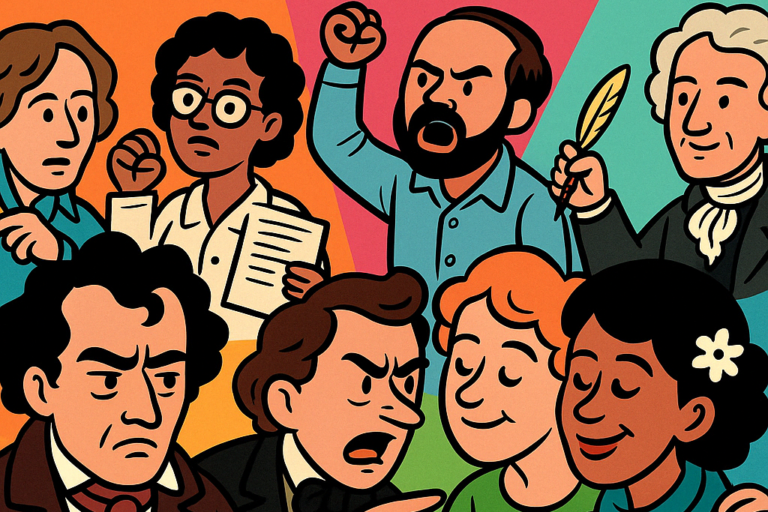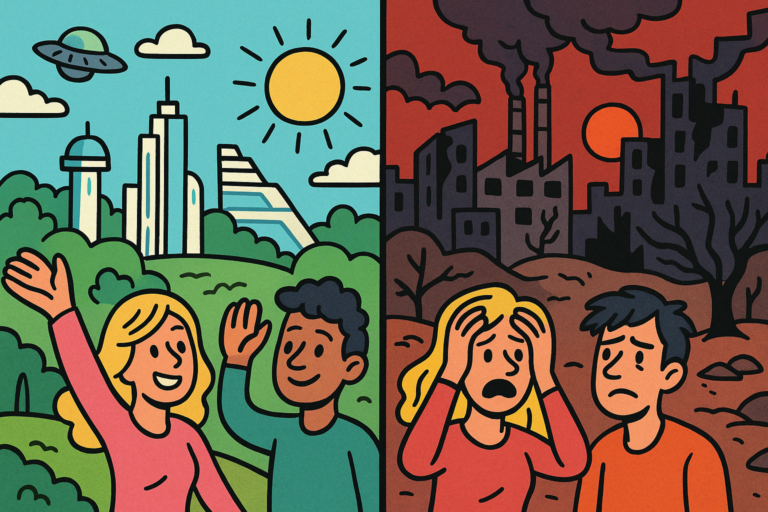Why Yesteryear Alternate-History Novels Failed To Predict Today’s Future

Alternate-history novels have always fascinated me—not just as “what if” playgrounds, but as tools that reveal how we understand the world at any given time.
These stories reflect our fears, our values, and our assumptions about how change actually happens. But the more I dove into the classics—books like The Man in the High Castle or Fatherland—the more I noticed a pattern: they rarely saw us coming.
I mean, we live in a world shaped by algorithms, climate collapse, global networks, decentralized protest movements, and billionaires launching themselves into space for fun.
Most alt-history writers of the past didn’t come close to imagining this. And that’s not just a miss in terms of creativity—it actually tells us a lot about how people used to think the future would work.
So in this post, I want to dig into why these novels got it wrong—and what that says about us, then and now.
Root Causes — Why Predictions Went Astray
So here’s where things got really interesting for me. When I started looking into why so many alternate-history novels missed the mark, I realized it wasn’t just about failing to predict certain tech or social shifts. It was about how they conceptualized change itself.
Let’s start with the big one:
A. Overemphasis on Geopolitical Divergences
Most classic alternate histories lean heavily on military and political outcomes—What if the Axis won WWII?
What if the South had won the Civil War?
The assumption was that these inflection points would completely rewire the modern world. But in hindsight, that logic feels overly deterministic.
Take The Man in the High Castle.
It’s an incredible piece of speculative fiction, but it’s rooted in the idea that Nazi or Japanese occupation of the U.S. would define everything about the future. What it doesn’t consider is how other forces—like digital tech, financial globalization, or decolonization—might have continued to evolve under the surface.
In our world, the Cold War ended, but instead of a unipolar utopia or dystopia, we got something messier: a fragmented, multipolar, data-driven world where non-state actors and networks often matter more than nations. That’s a big conceptual gap.
B. Underestimation of Technological Evolution
This one blew my mind. A lot of mid-to-late 20th-century alt-hist fiction imagined alternate presents where WWII-era tech persisted—radios, telegraphs, typewriters—but somehow in the year 2000.
There’s a clear reluctance to extrapolate technology beyond the moment of divergence.
Even in Harry Turtledove’s detailed universes, where he’s obsessive about plausibility, tech tends to remain oddly static. Contrast that with how quickly real-world computing advanced post-1950s.
Moore’s Law wasn’t just an engineering curve—it fundamentally reshaped how we live, think, govern, and protest.
If you asked most alternate history writers in the ’70s or ’80s to imagine a society shaped by global digital infrastructure, predictive algorithms, and decentralized currencies, they’d look at you like you were pitching science fantasy.
Tech was treated as set dressing, not as a generative force in its own right.
C. Static Views of Social Dynamics
This was the sneaky one.
Many alternate histories assumed that the power structures of the past would simply persist into the future—just with different names on top. In stories where the Confederacy survives or Nazi Germany wins, you often get scenarios where white supremacist hierarchies are frozen in amber.
What these stories missed was the way grassroots social movements, demographic shifts, and cultural hybridization can erode or reshape power from the bottom up.
For example, who in 1980 would’ve guessed that queer rights, once so marginal, would transform policy, media, and family structures within a few decades?
There’s also an underestimation of interconnectedness. Many older alt-histories imagined a world of sealed-off states or empires.
But today’s power flows through supranational systems: climate treaties, social platforms, supply chains. That’s not something a victorious Reich could’ve easily predicted—or controlled.
Recurring Tropes and Their Consequences
As I went deeper into alternate-history fiction, certain tropes just kept popping up like persistent weeds. Not only were they common—they were limiting.
These recurring narrative habits didn’t just shape how stories were told; they also shaped what kinds of futures authors couldn’t imagine.
Let’s break down four of the most dominant patterns that held the genre back from seeing a world even remotely like the one we’re in now.
1. The “What If the Nazis Won?” Obsession
Honestly, you could build a small library out of alt-hist novels built around the Axis victory scenario.
From The Man in the High Castle to Robert Harris’s Fatherland, and even newer riffs like Philip Kerr’s Berlin Noir series, the genre got really cozy with the idea of Nazi world domination.
And sure, it’s dramatic. It’s morally charged.
It makes for an instantly high-stakes world. But it also did something kind of damaging: it narrowed alternate history into an almost exclusively Euro-American conversation. The colonial world? Largely ignored. Africa, Latin America, South Asia? Occasionally props, never protagonists.
These Nazi-victory worlds are also usually rooted in a 1940s aesthetic. You get Zeppelins. Brutalist architecture. State propaganda machines and spy thrillers. And while all that’s gripping, it becomes a form of historical nostalgia, not meaningful speculation.
You don’t see, for example, how an alternate Nazi-led world might eventually need to digitize its bureaucracy, manage population surveillance, or contend with climate refugees.
More than anything, this trope showed me how alternate history often used the past to rehash old nightmares rather than explore plausible systemic evolution.
2. Technological Stasis
This one really baffled me. So many alternate-history settings present these sweeping political reimaginings—but then everyone’s still using radios, typewriters, maybe the occasional jetpack.
There’s often this assumption that if one historical fork had gone a different way, technological development would just freeze, or crawl forward slowly and predictably.
But let’s get real: tech doesn’t evolve in a vacuum, and it doesn’t obey neat timelines. After WWII, a mix of state investment, cold-war competition, and commercial acceleration drove rapid advances.
If the Allies hadn’t won, you’d still have people trying to improve computation, communications, and weaponry. Entire technological ecosystems would’ve still formed—just maybe with different initial conditions or motivations.
Alternate histories often skipped that.
They treated tech like scenery, not agency. Very few considered the logic of Moore’s Law, or how breakthroughs in materials science or computation would snowball across industries. Even fewer dared touch the bioengineering or AI revolutions we’re living through today.
So instead of extrapolating, the genre tended to recycle—offering dieselpunk aesthetics over dynamic innovation.
3. Binary Morality Systems
Another big trope: black-and-white morality. Alternate-history novels love good guys and bad guys. Rebels vs. empires.
Resistance fighters vs. jackboot fascists. And while that structure works great for tension, it doesn’t map neatly onto today’s very gray, very complex world.
Think about the modern challenges we’re dealing with—climate collapse driven by everyone, surveillance capitalism led by “cool” tech companies, data colonialism, global supply chains. The moral clarity of WWII just doesn’t apply.
But alternate histories often clung to that structure. You rarely saw ambiguous institutions, moral compromise, or decentralized harm. That makes for clean storytelling, sure—but it’s not predictive of the real complexity of power.
What we have now is a world where surveillance doesn’t wear jackboots—it comes with a slick UX and a “Like” button. The moral binaries of old-school alternate history just didn’t have the tools to describe that.
4. Nationalism as the Final Frame
And finally, nationalism. In alternate history, the nation-state is usually the central character. Every scenario hinges on national victories or collapses. But that’s just not how modern power plays out.
Corporations, social media platforms, NGOs, climate networks—they all operate above and beyond the nation-state. In fact, national governments often respond to these players instead of leading them.
But in alternate history, that shift almost never happens. The stories stay locked into 20th-century geopolitics.
Even when a world power changes—say, a Japanese-occupied America—the structure of the world remains state-centric, with borders, flags, and traditional hierarchies in place.
This has serious consequences for imagination. It blinds the genre to global supply chains, digital sovereignty, decentralized governance, and other real drivers of modern change. The nation remains the box that everything else must fit inside.
So we ended up with worlds that feel heavy on ideology but light on infrastructure. Visually rich but structurally shallow.
What Today’s World Tells Us About Future Fiction
So now that we’ve looked at how yesteryear’s alternate-history novels boxed themselves in—what are today’s writers doing differently?
Honestly, we’re living through one of the most exciting shifts in speculative fiction in decades.
A lot of creators are moving away from simple historical divergences and toward what I’d call speculative realism—stories that imagine not just different events, but different systems, forces, and relations.
1. Alternate-Present and Near-Future Are Taking Over
One big shift I’ve noticed is the rise of the “alternate present” or “near future” story, especially in the work of authors like Kim Stanley Robinson, Malka Older, or Chen Qiufan.
Instead of going, “What if Hitler won?” these stories ask, “What if climate negotiations actually worked?” or “What if social media became a literal voting mechanism?”
They feel urgent, grounded, and wildly plausible—because they’re based in existing structures, just tweaked a little to show us the road not yet taken.
The best part? They treat complexity with respect.
These stories assume readers can handle multipolar outcomes, intersecting crises, and ambiguous morality. There’s no easy fix, no villain to assassinate. Just humans grappling with systems bigger than themselves.
2. Systems Theory Is Quietly Reshaping Fiction
Here’s where it gets kind of meta. A lot of modern speculative fiction seems influenced by systems thinking—the idea that outcomes emerge from dynamic interplays between institutions, technologies, feedback loops, and human behavior.
You see this in climate fiction, especially. Instead of just flooding New York and calling it a day, books like The Ministry for the Future dig into international finance, population displacement, AI governance, and geoengineering.
They build worlds where policy matters, where long-term planning and unintended consequences take center stage.
Compare that to older alt-histories where changing a single assassination or battle was enough to remake the entire world. Today’s writers seem to understand that change is messy, nonlinear, and often slow—but that doesn’t make it any less compelling.
3. The Rise of Speculative Realism
I love this phrase—speculative realism—because it gets at what I think the best future-oriented fiction is doing right now. It’s not about prediction. It’s about plausible imagination.
Writers like Ted Chiang, Cory Doctorow, or Lavie Tidhar are exploring futures that don’t look flashy on the surface—but feel real.
Chiang’s short stories often hinge on one altered variable in language, memory, or math. Doctorow writes about digital rights, DRM, and economic collapse without needing aliens or nukes.
Tidhar’s work blends alt-history with metafiction, asking not “what happened” but “who gets to remember?”
These authors aren’t just crafting cool scenarios—they’re interrogating how we relate to change.
What’s worth preserving?
Who holds the power to imagine new systems? What if progress doesn’t feel like progress to everyone?
In short, speculative realism recognizes that the future isn’t one thing—it’s a battleground of possibilities, biases, and blind spots. That feels more relevant (and useful) than any Nazi dystopia ever could.
4. Fiction as a Tool for Navigating Uncertainty
Finally, there’s this growing sense that speculative fiction isn’t just escapism—it’s a form of cognitive scaffolding. In a world where tomorrow is wildly unpredictable, we need narratives that help us practice uncertainty.
And that’s where alternate history has room to evolve. Instead of just tweaking the past, maybe it can start asking: What are the untested possibilities inside the present?
What’s hiding in plain sight?
What kinds of futures are already being written—by policy decisions, codebases, cultural shifts?
I’d love to see more alt-history that blends the rigor of the past with the imagination of the future.
That’s where the real magic lies.
A Quick Thought to Leave You With…
So yeah, yesteryear’s alternate-history novels missed the future—not because they weren’t smart or bold, but because they were trapped by the assumptions of their time.
They told powerful stories, but within narrow frames.
Today, we’ve got the tools—and the urgency—to tell bigger, messier, more honest ones.
And who knows?
Maybe someone in 2085 will look back at our fiction and wonder how we could’ve possibly missed what came next.
But at least we’ll know we tried to see further.





